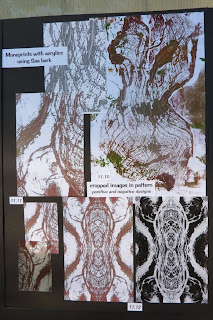
I simplified the main green motif in a drawing then prepared it in green and red chiffons and organzas in various sizes, sewn on water soluble fabric then cut out by soldering. This will keep the translucency of the layers.

I placed the motifs onto a 'red' background and felt that more 'obvious' lacework was required so chose to sew the meandering green line of the pattern in an open green lace. I've tried a couple of further lace patterns below in pinks/reds create layers.
In this first idea the fabric will consist of two layers - 1 the motifs and lacework will be an entity of its own and 2 the under layer of reddish organza and chiffon. The under layer needs to have a bit more texture / pattern akin to the original monoprint but I don't want to detract from the upper lacework. I've only randomly tucked and pleated the organza then soldered slits in it to change the colour.

I've also looked at creating the pattern on one fabric where I've used painted Lutradur, resist embroidered then heat gunned away the rest. The linking 'vine' is a couched cord made from red organza. I like the lacy effect but it feels 'crusty' as you'd imagine after melting a polyester web so not sure if it's a suitable choice for a 'wearable'. The background dyed cotton has texture from dyed Saa bark but would need to be darker in colour.

The straps could be principally a braid perhaps with threaded motifs echoing those in the dress. The photo is a bit dark but I've tried a 5 stranded braid using machined cords in green and red and that seems to be a suitable width. I've tried the red motifs in different thicknesses with and without interfacing, and tried lacing them differently.
And with so much pattern I thought the bodice area should be fairly plain, perhaps rouched or pleated chiffon.































 I didn't get to translate this into fabric in the time at Urchfont but I'm working on the same principles to reflect some lacy structures in vegetation designs that I've been creating in Module 1 (more later, hopefully).
I didn't get to translate this into fabric in the time at Urchfont but I'm working on the same principles to reflect some lacy structures in vegetation designs that I've been creating in Module 1 (more later, hopefully).



 This photo shows everyone's structures in situ before they are are completely dry, along with their inspiring artwork from which the colour scheme and patterns were drawn.
This photo shows everyone's structures in situ before they are are completely dry, along with their inspiring artwork from which the colour scheme and patterns were drawn.